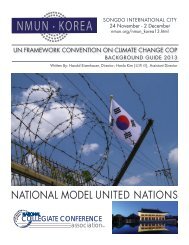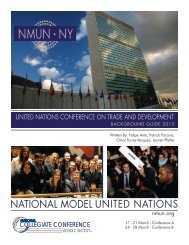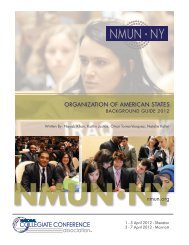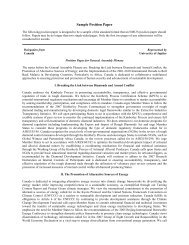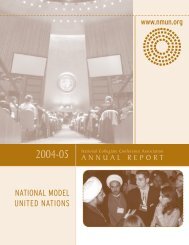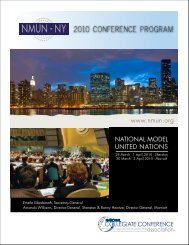UNFPA Background Guide - National Model United Nations
UNFPA Background Guide - National Model United Nations
UNFPA Background Guide - National Model United Nations
Create successful ePaper yourself
Turn your PDF publications into a flip-book with our unique Google optimized e-Paper software.
Challenges of Migration<br />
Irregular migration is an ongoing challenge for the international community leading to a number of risks and<br />
insecurity for migrants. 298 Irregular migration describes migration without documents or false documents leaving<br />
migrants with no legal status in the country of destination. 299 Irregular migrants include also those that have entered<br />
the country legally, but whose legal stay has expired. 300 Besides the many positive implications of migration for<br />
countries of destination, which benefit from work forces, human development, and the empowerment especially of<br />
women, migration poses many challenges on the countries of origin. 301 One of them is that not only uneducated<br />
people leave to work abroad, but also highly educated personnel that are seeking a better future in a more developed<br />
country. 302 This “brain drain” then slows down the development of the home country. 303 Another pattern that<br />
<strong>UNFPA</strong> is observing especially in some Central Asian States is the stagnation of the use of modern contraceptives,<br />
hormonal and long-term methods. 304 As migration rates in Central Asian States are rising, governments try to<br />
increase fertility rates again to make up for population lost to migration. 305<br />
Benefits of International Migration<br />
Besides the existing challenges, there are a number of possible benefits for countries of origin and destination if<br />
migration is handled properly. 306 Policy-makers often fear that brain drain will harm their public services and<br />
economies due to the emigration of skilled personnel. 307 While this is a legitimate concern, migration also holds<br />
many chances for countries. 308 Migrants who have been trained and qualified abroad, can add to their home<br />
country’s development on their return, given that the transition is made easy for them and they are reintegrated into<br />
society. 309 At the same time, research shows that when the number of people leaving the country rises, there is also a<br />
rise in the number of people that wish to gain skills in their home country. 310 Thus, policy-makers must establish<br />
incentives and services, especially but not only for young people to receive education and training at home instead<br />
of migrating. 311 Another benefit for home countries is remittances send back by emigrants to support their<br />
families. 312 These remittances are prime sources of foreign exchange earnings for some countries and an<br />
indispensable addition to their gross domestic product (GDP). However, one must pay attention that remittances<br />
might also add to inflation and foster inequalities between households benefiting from remittances and those that do<br />
not. 314 Furthermore, remittances can only have a positive effect when they reach their destination. 315 The latter is not<br />
always the case due to insufficient infrastructure in a migrant’s home country, which hinders financial aid to reach<br />
the respective families. 316<br />
Migration and Human Rights<br />
There remain several key obstacles for migrants in getting into a position to be able to contribute economically,<br />
socially and culturally to their host country’s society. 317 However, there are still countries where migrants’ rights are<br />
298<br />
<strong>UNFPA</strong>, Meeting the Challenges of Migration Progress since the ICPD, 2004, p. 8-9.<br />
299<br />
Ibid., p. 16.<br />
300<br />
Ibid., p. 16.<br />
301<br />
Ibid., p. 8-9.<br />
302<br />
<strong>UNFPA</strong>, State of the World Population 2006, 2006, p. 3.<br />
303<br />
<strong>UNFPA</strong>, Meeting the Challenges of Migration Progress since the ICPD, 2004, p. 34.<br />
304<br />
<strong>UNFPA</strong>, Annual Report 2012, p. 34.<br />
305<br />
Ibid., p. 34.<br />
306<br />
International Organization for Migration, Mainstreaming Migration into Development Planning, 2010, p. 12.<br />
307<br />
Ibid., p. 13.<br />
308<br />
UN Department for Economic and Social Affairs, Interview with the Director of the Population Division of UN DESA, John<br />
Wilmoth, 2013.<br />
309<br />
International Organization for Migration, Mainstreaming Migration into Development Planning, 2010, p. 13.<br />
310<br />
Ibid., p. 13.<br />
311<br />
<strong>UNFPA</strong>, Annual Report 2010, 2010, p. 5.<br />
312<br />
UN General Assembly, Summary of the High-level-Dialogue on International Migration and Development: Note by the<br />
President of the General Assembly (A/61/515), 14 October 2006, p. 3.<br />
313<br />
<strong>UNFPA</strong>, Meeting the Challenges of Migration Progress since the ICPD, 2004, p. 25.<br />
314<br />
International Organization for Migration, Mainstreaming Migration into Development Planning, 2010, p. 17.<br />
315<br />
<strong>UNFPA</strong>, State of the World Population 2006, 2006, p. 14.<br />
316<br />
Ibid., p. 14.<br />
317<br />
Global Migration Group, International Migration and Human Rights, 2008, p. 2.<br />
38



